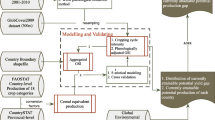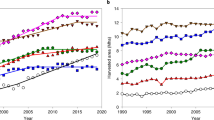Abstract
Raising crop yield per unit land area remains a key to eliminating food shortages given limited land resources. However, Africa still falls far behind other continents in crop yield and there is major variation across regions within Africa. This paper analyzed regional yield gaps and yield convergence in Africa for four major crops: maize, millets, sorghum, and cassava. The club convergence test was employed to test whether yields are converging in Africa. Our results found no evidence of population convergence as a whole for any of the crops. However, we found that crop yields are converging into several clubs or groups of countries, implying successful technology diffusion and use within, but not between, specific regions. Furthermore, we predicted the attainable output for the four crops based on club convergence using the highest actual yield in each club as the attainable yield for all countries in the same club, and found that the gap between actual output and attainable output is narrowing gradually. Nevertheless, actual output could still increase by 70% if all countries reached the yield frontier, which we defined as the highest actual yield in each club. We suggest that policies aiming to end hunger in Africa should focus on eliminating barriers to technology diffusion and use of agricultural support mechanisms between countries, particularly those in the same club.





Similar content being viewed by others
Notes
If there is no convergence for the whole sample, it can be that countries converge into several different steady state levels, which are named as convergence clubs (Phillips and Sul 2007).
The ranking is based only on the last fraction rather than whole period, that is because the yields in the last fraction are more similar to the long-run steady-state level. Therefore, regions with higher yields in the last fraction are more likely to be in the core group. Using the last third or half to rank the yield of all countries can significantly reduce the number of steps needed for identifying convergent clubs according to the simulation by Phillips and Sul (2007). Using different fractions for ranking will get the same results, but starting with the last fraction can shorten the time used for the convergence test.
Output gap is defined as “The gap between attainable and actual output”.
References
Adjognon, S. G., Liverpool-Tasie, L. S. O., & Reardon, T. A. (2017). Agricultural input credit in Sub-Saharan Africa: telling myth from facts. Food Policy, 67, 93–105.
Alexandratos, N., & Bruinsma, J. (2012). World agriculture towards 2030/2050: the 2012 revision. Rome: FAO.
Apergis, N., Christou, C., & Miller, S. (2012). Convergence patterns in financial development: evidence from club convergence. Empirical Economics, 43(3), 1011–1040.
Balmford, A., Green, R. E., & Scharlemann, J. P. W. (2005). Sparing land for nature: exploring the potential impact of changes in agricultural yield on the area needed for crop production. Global Change Biology, 11, 1594–1605.
Barro, R. J., & Sala-i-Martin, X. (1992). Convergence. Journal of Political Economy, 100(2), 223–251.
Becker, R., Enders, W., & Lee, J. (2006). A stationarity test in the presence of an unknown number of smooth breaks. Journal of Time Series Analysis, 27, 381–409.
Benin, S., Nin Pratt, A., Wood, S. & Guo, Z. (2011). Trends and spatial patterns in agricultural productivity in Africa: 1961–2010. ReSAKSS Annual Trends and Outlook Report 2011. International Food Policy Research Institute (IFPRI).
Bernard, A. B., & Jones, C. I. (1996a). Productivity across industries and countries: Time series theory and evidence. Review of Economics and Statistics, 78, 135–146.
Bernard, A. B., & Jones, C. I. (1996b). Productivity and convergence across US states and industries. Empirical Economics, 21, 113–135.
Breitung, J., & Pesaran, H. (2008). Unit roots and cointegration in panels. In L. Matyas & P. Sevestre (Eds.), The Econometrics of Panel Data: Fundamentals and Recent Developments in Theory and Practice (pp. 279–322). Berlin: Springer.
Brown, L. R. (2001). Eradicating hunger: a growing challenge. In In State of the World 2001. New York: World Watch Institute, Norton.
Cistulli, V., Heikkila, M., & Vos, R. (2016). Global dimensions of malnutrition: territorial perspectives on food security and nutrition policies. In OECD (Ed.), OECD Regional Outlook 2016. Productive regions for inclusive societies (pp. 281–294). OECD Publishing: Paris.
Enders, W., & Lee, J. (2012). A unit root test using a Fourier series to approximate smooth breaks. Oxford Bulletin of Economics and Statistics, 74, 574–599.
Evans, P. (1998). Using panel data to evaluate growth theories. International Economic Review, 29(2), 249–265.
Evans, L. T., & Fischer, R. A. (1999). Yield potential: Its definition, measurement, and significance. Crop Science, 39, 1544–1551.
FAO. (2016). The State of Food and Agriculture 2016. Climate change, agriculture and food security. Rome: FAO.
FAO. (2017). The future of food and agriculture-Trends and challenges. Rome: FAO.
FAO, WFP, & IFAD. (2012). The State of Food Insecurity in the World 2012- Economic growth is necessary but not sufficient to accelerate reduction of hunger and malnutrition. Rome: FAO.
FAO, IFAD, UNICEF, WFP, & WHO. (2017). The State of Food Security and Nutrition in the World 2017. Building resilience for peace and food security. Rome: FAO.
Fermont, A. M., van Asten, P. J. A., Tittonell, P., van Wijk, M. T., & Giller, K. E. (2009). Closing the cassava yield gap: An analysis from smallholder farms in East Africa. Field Crops Research, 112(1), 24–36.
Filmer, D., & Fox, L. (2014). Youth employment in sub-Saharan Africa. Washington, DC: World Bank.
Fischer, R.A., Byerlee, D., & Edmeades, G.O. (2009). Can technology deliver on the yield challenge to 2050?. Paper prepared for the Expert Meeting on How to feed the World in 2050. Food and Agriculture Organization of the United Nations. Available at: http://www.fao.org/tempref/docrep/fao/012/ak977e/ak977e00.pdf. Access 26 June 2009
Godfray, H. C. J., Beddington, J. R., Crute, I. R., Haddad, L., Lawrence, D., Muir, J. F., et al. (2010). Food security: The challenge of feeding 9 billion people. Science, 327, 812–818.
Greene, W. H. (2002). Econometric analysis (5th ed.). Prentice Hall: Upper Saddle River, New Jersey.
Holden, S. T., & Ghebru, H. (2016). Land tenure reforms, tenure security and food security in poor agrarian economies: causal linkages and research gaps. Global Food Security, 10, 21–28.
Islam, N. (1995). Growth empirics: A panel data approach. Quarterly Journal of Economics, 110(4), 1127–1170.
Lau, C. K. M. (2010). New evidence about regional income divergence in China. China Economic Review, 21(2), 293–309.
Lichtenberg, F. R. (1994). Testing the convergence hypothesis. The Review of Economics and Statistics, 76(3), 576–579.
Licker, R., Johnston, M., Foley, J., Barford, C., Kucharik, C. J., et al. (2010). Mind the gap: how do climate and agricultural management explain the ‘yield gap’ of croplands around the world? Global Ecology and Biogeography, 19(6), 769–782.
Lynd, L. R., & Woods, J. (2011). A new hope for Africa. Nature, 474, 20–22.
Mankiw, N. G., Romer, D., & Weil, D. N. (1992). A contribution to the empirics of economic growth. Quarterly Journal of Economics, 107, 407–437.
Neumann, K., Verburg, P. H., Stehfest, E., & Müller, C. (2010). The yield gap of global grain production: Spatial analysis. Agricultural Systems, 103(5), 316–326.
Newey, W. K., & West, K. D. (1987). A simple, positive semi-definite, heteroskedasticity and autocorrelation consistent covariance matrix. Econometrica, 55(3), 703–708.
Nin-Pratt, A., Johnson, M., Magalhaes, E., You, L., Diao, X., et al. (2011). Yield Gaps and Potential Agricultural Growth in West and Central Africa. Washington D.C.: International Food Policy Research Institute.
Pesaran, M. H. (2007). A simple panel unit root test in the presence of cross-section dependence. Journal of Applied Econometrics, 22(2), 265–312.
Phillips, P., & Sul, D. (2007). Transition modeling and econometric convergence tests. Econometrica, 75(6), 1771–1855.
Quah, D. H. (1993). Galton’s fallacy and the convergence hypothesis. Scandinavian Journal of Economics, 95, 427–443.
Sala-i-Martin, X. (1996). Regional cohesion: Evidence and theories of regional growth and convergence. European Review of Economic Review, 40, 1325–1352.
Schwan, S., & Yu, X. (2018). Social protection as a strategy to address climate-induced migration. International Journal of Climate Change Strategies and Management, 10(1), 43–64.
Tian, X., & Yu, X. (2015). Using semiparametric models to study nutrition improvement and dietary change with different indices: The case of China. Food Policy, 53, 67–81.
Tian, X., Zhang, X., Zhou, Y., & Yu, X. (2016). Regional income inequality in China revisited: A perspective from club convergence. Economic Modelling, 56, 50–58.
van Ittersum, M. K., Cassman, K. G., Grassini, P., Wolf, J., Tittonell, P., & Hochman, Z. (2013). Yield gap analysis with local to global relevance a review. Field Crops Research, 143, 4–17.
von Braun, J. (2007). The world food situation. IFPRI Food Policy Report.
Yu, X., & Shimokawa, S. (2016). Nutrition impacts of rising food prices in African countries: A review. Food Security, 8(5), 985–997.
Author information
Authors and Affiliations
Corresponding author
Ethics declarations
Conflict of interest
The authors declare that they have no conflict of interest.
Rights and permissions
About this article
Cite this article
Tian, X., Yu, X. Crop yield gap and yield convergence in African countries. Food Sec. 11, 1305–1319 (2019). https://doi.org/10.1007/s12571-019-00972-5
Received:
Accepted:
Published:
Issue Date:
DOI: https://doi.org/10.1007/s12571-019-00972-5




